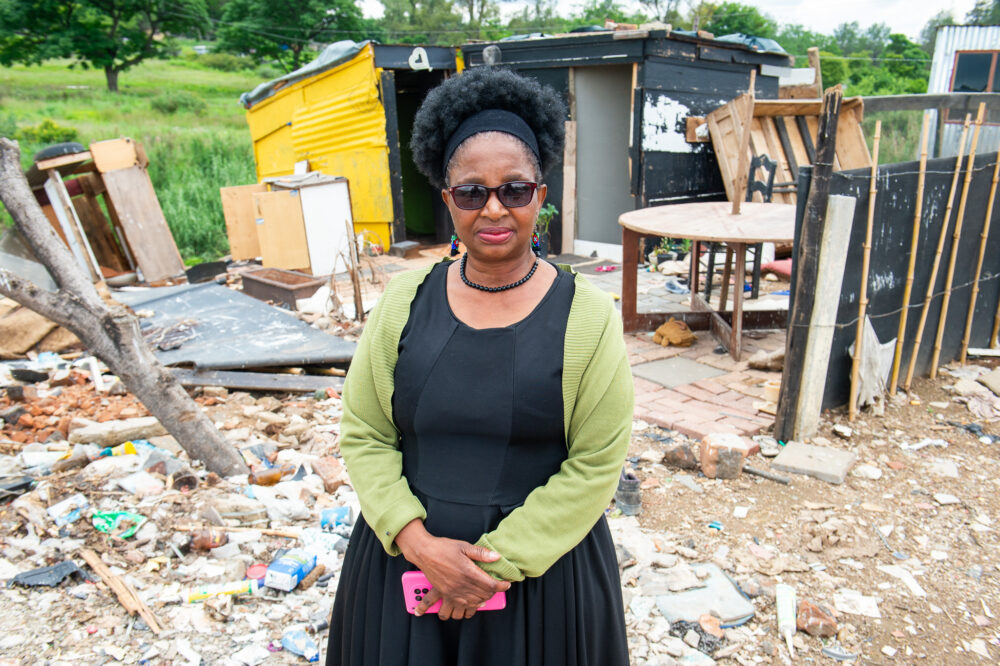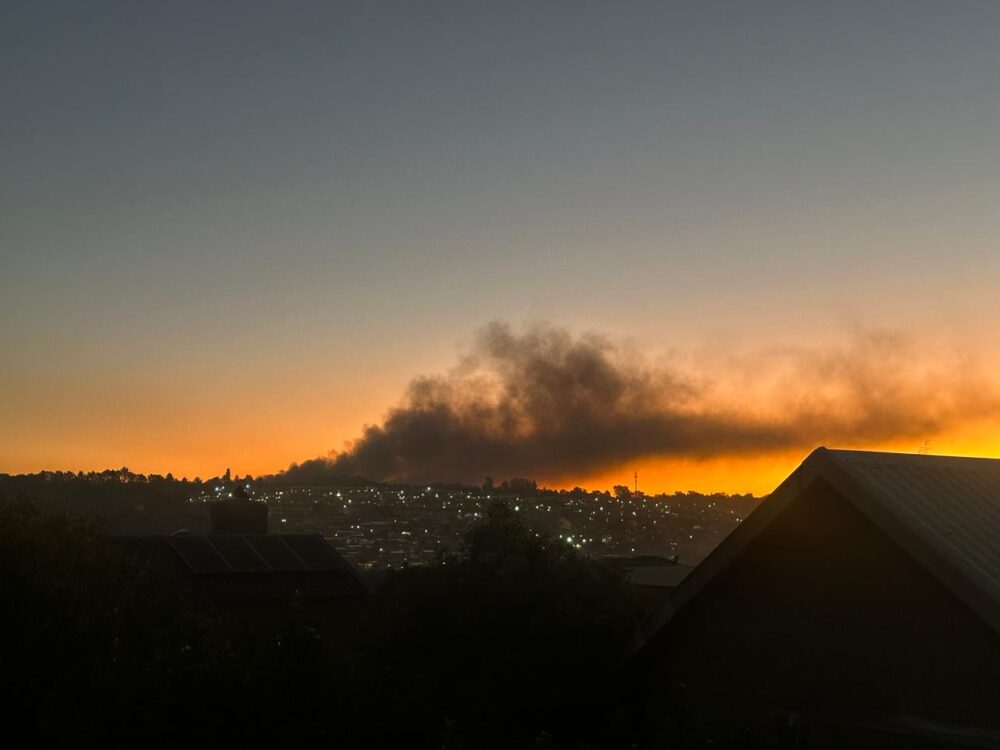Toxic smoke: The illegal dumping site from Cedar Creek forces residents to breathe an acrid haze from nightly burning. Photo: Supplied
Before Maria Pule goes to sleep at night, she wedges wet towels into the cracks of her windows and doors. It is the only way she can breathe.
“That’s how we survive because the smell is unbearable,” she said from her home in Kya Sands Estate, north of Johannesburg. “I’m staying right at the back where the dump is. You cough, and you cough.”
Across northern Johannesburg — from Kya Sands and Cosmo City to Fourways, Northriding, Bloubosrand and Chartwell — thousands of residents like Pule choke on an acrid haze of toxic smoke from uncontrolled illegal dumping and nightly waste burning.
At night, the skyline turns grey as illegal waste fires sweep through mountains of discarded household waste, building debris, electronic, medical waste and toxic materials such as asbestos.
“You can’t open the windows or doors. You can’t hang your washing outside because you’re walking through smoke. It smells like burning copper and cables,” said Pule.
How the problem started
In 2010, the City of Johannesburg issued a decommissioning license for the Kya Sand waste-disposal site. The moment it withdrew in 2015, the illegal dumping started.
Over time, organised criminal networks reoccupied the landfill and surrounding land, turning them into sprawling, unregulated commercial waste hubs.
The Kya Sands Burning Wasteland Community Forum said these operations dominate the region’s informal waste economy. At its peak, about 10 illegal dumps operated and at least five remain active today.
“Waste lords” direct trucks, collect dumping fees, strip and resell recyclable materials, and at night set fire to whatever cannot be sold to clear space for the next day’s loads.
They burn plastic, rubber, cable casings, solvents, paint, medical waste and household refuse in the open air, creating a chemical cocktail that drifts into homes, schools and workplaces.
The forum estimates that up to 200 trucks arrive daily, dumping tonnes of household, building, electronic, medical and other toxic waste. Dumping fees range from R300 to R800 per load, and several million rands are generated each month through illegal dumping, recycling operations, copper stripping, land-renting schemes and scrap resale.
Keith Elliott, a Broadacres resident and spokesperson for the forum, remembers the night he realised the community needed to act.
“I got home one evening in 2020 and stepped out of my car into a cloud of the most toxic, grossest smoke you can imagine,” he recalled.
An informal group of residents registered a non-profit company that has successfully taken the authorities to court. The forum argues that the municipality and the Johannesburg Metropolitan Police Department (JMPD) have proven incapable of controlling criminal operations involving syndicate networks and “military-grade weapons”.
 Can’t breathe: Maria Pule wedges wet towels into the cracks of her windows and doors to sleep at night. Photo: Delwyn Verasamy
Can’t breathe: Maria Pule wedges wet towels into the cracks of her windows and doors to sleep at night. Photo: Delwyn Verasamy
Empty promises
There has been a litany of broken promises and missed deadlines, the forum said. In August 2021, Pikitup’s board and executives toured the site and promised urgent action.
In January 2022, the city’s environmental and infrastructure services department released a 30-page environmental and enforcement strategy, but it was never implemented.
The city missed the deadline for its court-ordered air-quality study granted by the Johannesburg high court in August last year. The study was initially due in April this year, but was extended to July. Testing began in August, and results are expected in the first quarter of 2026.
The health effects are immense, as burning toxic waste releases benzene, ethylbenzene, heavy metals and carcinogenic particles.
Independent air-quality studies commissioned by the forum have directly linked dangerously high levels of toxic chemicals to the dumps. These concentrations, which include benzene and ethylbenzene exceeding national limits, pose a serious threat.
Potential health concerns include increased rates of respiratory and heart disease, cancer and hormone disturbances, developmental and neurological harm, particularly among children and the elderly.
Toxic smoke drifts across Fourways, Cedar Lakes, Bloubosrand, Cosmo City, Northriding, Chartwell, Riverbend, Zandspruit and beyond — affecting more than 150 000 people.
Northern Johannesburg “has become one of the city’s most polluted micro-environments”, the forum said. Beyond the dirty air, none of the illegal sites are lined or contained, risking contamination of surface and groundwater.
“Landfills such as the decommissioned Kya Sand site produce methane — a highly explosive gas. When exposed to open flames or even heat, it can ignite with devastating force. A single spark can trigger a violent explosion. Pikitup, JMPD and the city have allowed illegal dumping and burning at the decommissioned Kya Sand Landfill,” the forum said.

‘Hotspot of illegal dumping’
In May, the city awarded a R150 million tender to secure and rehabilitate the main dump and access was restricted by trenching the entrance.
While this reduced activity on that site, illegal dumping simply shifted to neighbouring land.
“The problem didn’t disappear — it just moved closer to residential areas,” Elliott said. “We’re grateful the city is addressing part of the problem. But we need a comprehensive solution. There are still four or five other active sites.”
In October, the forum’s WhatsApp group surged from 600 to more than 1 600 people as new illegal sites were started, affecting more households.
The city, in a September statement, acknowledged that the closed landfill had become a hotspot for widespread illegal dumping, “impacting the environment, local businesses and nearby communities”. “Smoke from burning waste has reduced air quality to below 35% in Fourways, Cedar Lakes and Bloubosrand, affecting an estimated 80 000 residents,” it said.
Its project at the Kya Sands dump aims to restore environmental integrity, improve air quality and safeguard public health.
Key interventions include clearing and recycling illegally dumped waste, developing and implementing a rehabilitation plan, installing security measures, restoring the landfill’s boundary wall and conducting long-term environmental monitoring of water and air quality.
Nthatisi Modingoane, the spokesperson for the city, told the Mail & Guardian that addressing waste and air quality is a priority. “While significant challenges remain, concrete actions are underway and the City will continue to take steps; including under court supervision – to restore environmental safety, uphold public health and support the long-term recovery of the area.
Modingoane said the city noted the concerns raised in the recent article regarding air quality in the Kya Sands area.
“We wish to confirm that the city is actively implementing the directives outlined in the court order as part of the broader Kya Sands rehabilitation plan. Air quality monitoring in the area is currently underway. An independent and suitably qualified consultant has been appointed to conduct both passive and active sampling to ensure that the date collected is accurate, credible and aligned with regulatory requirements.”
He said that while the city did experience delays in the deployment of monitoring instruments, the monitoring programme is now fully underway.
The campaign will run for a full three-month period, after which a comprehensive report will be prepared. This report will be submitted to the court and shared with the Kya Sands Community Forum to ensure transparency and accountability.
Pikitup said a “committee comprising of provincial government” has been established to deal with the Kya Sand issues and referred the M&G to the environment and infrastructure services department.
Back to court
The forum said it was insufficient to secure only one site — all illegal activities must be targeted. In September, it filed a new notice of motion against 12 government entities. Arguing that authorities failed to protect residents’ health and the environment, they seek a court-ordered, urgent, coordinated response.
The community is calling for illegal dumping and burning sites to be identified and mapped, for environmental and health assessments to be conducted, and for a system to monitor and prevent further pollution to be established. Residents also want regular progress reports submitted to the court to ensure accountability.
“We need a comprehensive solution, and that’s the nub of our notice of motion now — where national, provincial and local resources are brought to bear on the problem,” Elliot said.
Living with the smoke
Residents living downwind of the illegal dumps describe the same daily battle: asthma flares, chest infections, sore throats, headaches and red, burning eyes.
Rene Anderson, who lives in Talavera Estate in Craigavon, said the smoke has become unbearable since early October.
“It’s so potent — like burnt rubber, but more intense. Some nights you wake up at 1am, and you cannot breathe,” Anderson said. “It’s terrible. We had to buy an air purifier. We had to seal the windows. We lock ourselves in one room with our dogs and the air purifier just to be able to breathe. I even bought a gas mask.”
Her neighbour, Michelle Rossouw, said opening a window instantly triggers a pounding headache. Her partner was recently hospitalised with severe pneumonia. “I can’t prove it’s because of this,” Rossouw said. “But I don’t think it helped.”
For Pule, the anxiety is constant. She no longer allows her grandchildren to visit, fearing what they could inhale. “Even if you want to sell the house, buyers are greeted by that smell,” she said. “We complain to the council, to all the relevant parties. They say they’ll assign people — but nothing happens. You’re left trying to figure out how to breathe in your own home.”